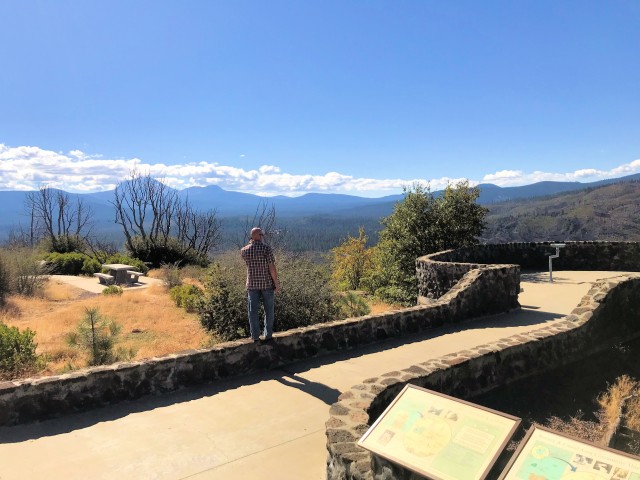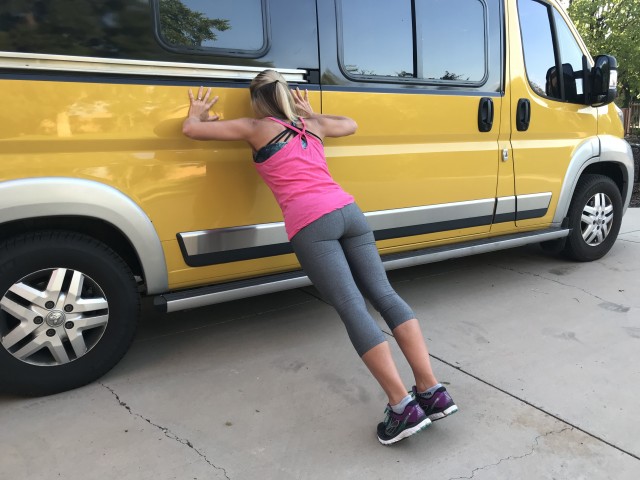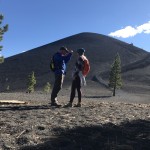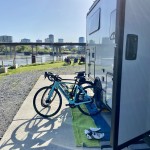This post may contain affiliate links.
Okay confession time:
James and I are both absolutely TERRIBLE with time-management.
I can hear our friends reading this now, nodding emphatically while saying “oh heck yes they are.” It’s weird because in most other ways James and I complement each other quite nicely. His weaknesses are my strengths and vice versa.
For the most part we’ve got a good yin and yang thing going…

But when it comes to time, and pretty much only this area, we both seem to be simultaneously missing the gene. Since we both lack it, no one’s checking and balancing the other, and we end up doing those things time-challenged people do: underestimating how much time things will take, last minute rushing, losing track of time, those sorts of things.
It’s especially obvious when we plan trips. We tend to get, well let’s call it “enthusiastic”.
We are most attracted to epic trips… things far away, the more complicated the better! So, we squeeze too much into our window of travel time, and that leaves us doing marathon driving days.
I’m certainly not proud of it, especially how it goes against the FitRV message of staying fit-focused. So I guess that makes us hypocrites as well as flawed humans. Welcome aboard!!!
In our defense it’s not JUST our time-challenged ways to blame for our crappy driving habits, it’s also James’ PDJ (pesky day job). Since we’re scheduling trips around his PDJ, it means we have less flexibility in taking our time to get anywhere.

James’ office for the day: a PDJ conference call at a roadside stop. Poor James…
Physiologically speaking, we simply aren’t a sedentary species. Our bodies can handle sitting only temporarily, and then they start experiencing a negative cascade of effects such as:
- Poor Circulation: Our bodies depend on us being active to keep our circulation up. When we’re idle for long stretches, fluids pool, fatty acids accumulate, nutrients aren’t getting delivered as efficiently as they should, and the efficient exhaust of cells is prevented. Think of it like not taking the trash out for many days. It accumulates and leaves behind a pretty toxic environment. And let’s not forget about the potential for life-threatening blood clots like deep vein thrombosis (DVT).
- Slowed Metabolism: When you sit, the production of enzymes used to process fat drop by about 90%, thereby triggering fat storage instead of using fat for fuel as it does when we’re moving. Too much sitting also reduces your ability to use blood sugar and can lead to insulin resistance and ultimately Type 2 diabetes.
- Weakened Muscles and Bones: Our musculoskeletal systems work under the rule of “use it or lose it,” so when we sit for long durations, in a sense it goes into “shut-down” mode. Bones are living, just like the rest of our systems, and are constantly undergoing a “remodeling” process similar to muscles, breaking down and building back up again. When we’re sitting all day on a road trip, however, they aren’t triggered to rebuild appropriately, and the remodeling process goes idle along with you. Long drives can cause nerve compression between muscles and bones, resulting in inflammation, pain, and it ultimately makes us more prone to injury.
- Foggy Brain: Physical activity makes you smarter, we all know this. The way it does that is by triggering the production of brain-derived neurotrophic factor (BDNF) which is responsible for the growth of neurons. BDNF also fights the effects of the stress hormone cortisol. When sitting, our bodies hold on to harmful hormones like cortisol while thwarting the production of helpful hormones and neurotransmitters like BDNF. Your brain requires vital oxygen and nutrients to keep you sharp and in a good mood, however the lowered circulation from long periods of sitting keeps that from happening effectively.
To lead a health-focused life, we really should avoid being on the road longer than an 8 hour day… that’s just way too much sitting and our bodies aren’t designed for that. So to combat those ill effects, we’ve set down some ground rules for healthing-up long drives. Here’s our #1 Fit RVers Rule of the Road:
The FitRV’s Rest Stop Recharge Rule:
Whenever roadtripping, stop after a maximum of 2 hours of driving. During the stop, get 15 minutes of moderate-intensity physical activity before getting back on the road.
Now, the 2-hours thing, I need to point out that’s a MAX. If you are roadtripping solo or not switching drivers each time you stop, you should stop more frequently than that. The most ideal situation is stopping every hour with 10 minutes of moderate-intensity exercise, but I realize that’s not always realistic.
Plan Your Recharge Stops Ahead of Time:
To make the stops fun, here’s what we do:
- Being old-school book lovers, we head to our book shelf and peruse books like “50 States, 5,000 ideas” by National Geographic, or “1,000 Places to See Before You Die” to see if we can find anything interesting near our route. And by the way, books like these make excellent gifts for RVers!
- We also turn to websites like Roadside America or Roadtrippers.
We use both the books and the websites to find unique roadside attractions every 90 minutes to 2 hours along our route. Having an itinerary of fun & frequent stops already planned out before you go completely changes the dynamic of the long drive and gives you things to look forward to. It makes the drive feel more like part of the vacation and gets you out of that MUST-HURRY-AND-GET-THERE mindset. So you stop at your pre-planned attraction, see something cool, and then do your 15 minutes of activity right there.

What This Looks Like:
An 8-hour driving day means you’d have 3 rest-stop recharges during the drive which totals 45 minutes of exercise. You should also do another 15 minutes of exercise once you land, so that gives you a full hour of moderate-intensity physical activity. You’ve effectively amped up your circulation 4 different times throughout your day, combating any ill effects of marathon stretches of sitting… that’s more exercise than most people get in a day!
I do want to point this out:
Long drives really should be avoided. There is research that shows that the more we sit, the more health-compromised we are. So, as you plan trips DON’T be like James and me and instead keep your drive time to a minimum. No one should be sitting for long stretches in a day if it can be helped. BUT! When it’s unavoidable, give our rest stop recharge strategy a try. It’s a good balance… you get your drive done, you get your exercise in, AND you see a cool roadside attraction.

Always love hearing your suggestions, too. Leave comments below and happy FitRVing, friends!
xoxo, Stef











Hmmm. Our common trip lately is to go to Calumet, in the Mich UP, from Kalamazoo, near the Indiana border on the West side of the LP, an 11 hour drive or so. Our strategy is to do a normal morning workout (walk, run or bike) and then, some $$ paying work in the afternoon, and then eat dinner eventually, and then get in the van and go 5 hours to about the Mac bridge, where we sleep. (either before or after, many options)
In the morn, wake up, have some coffee and get going, arriving at the Swedetown ski area (Calumet) in the early afternoon, to put on some k’s.
So, we definitely go longer that do you in the driving seat, but we still get some excercise.
It’s all planning.
Just found your site and it is a wealth of information. Was searching for nationwide gyms, so found your article on that. This one was another great one but what intrigued me was the picture of the Swedish Dala häst. Where is that?
We are a low/mid 50’s couple that exercise daily and want to make sure we keep that up as we start our new adventure. We built our own Tiny House On Wheels and will soon be starting our “a month in every state – 48 month tour”. Just found you on IG as well. Check us out at TinyLivingLivingLarge
Long ago I used to do a marathon 13 hours between my home in Oregon and my folks home in Carmel during Christmas week. Long ago. Nowadays it’s switch off every hour and potty walk the dog, food breaks every 3 hours. Knocks down our maximum mileage to 300 per day, but that’s a 6-hour day and more than enough driving time in a car, much less an RV, which takes more effort to drive.
I’d suggest to get your daily exercising done BEFORE you hop in the vehicle. Once you’re there and driving, you won’t want to stop for the hour it takes for a good workout or brisk walk.This means not launching until maybe 10 AM, typically, but if you’re not in an area where that’s a traffic issue, who cares?
The alternative is to plan active attraction stops every 150 miles or so. Easier said than done in the West, but quite doable in the East. Pushes your daily arrival time a bit later, but did you get an RV to keep to a schedule?
Getting a big workout in before hitting the road is great advice! And I’m glad to hear you’re stopping every hour, good for you!
Yes, I have been a huge transgressor of these good guidelines. In fact, I used to joke about getting a catheter to increase range between stops. I am almost 59 now so these tips are worth trying. And…….we’ll be taking delivery on our 2019 Travato 59KL in two weeks, so we’ll have plenty of opportunity! Thank you both for being a HUGE part of the educational process that preceded this purchase!
David, I’m glad you’re leaving behind the catheter days (lol) and are ready to try some frequent stopping… NICE! And hey, so wonderful about your new Travato, CONGRATS!!! Here’s to incredible adventures ahead (with lots of stops along the way of course)!!! xoxo
My wife MUST have her 2 hr power walk every morning and we are going to be hitting the road for 2wks every month and are concerned about that being possible as we plan to travel mainly back roads. Any ideas?
Good for her; sounds like it’s a pretty ingrained habit. Since she’ll be power-walking in unknown territory, first and foremost make sure she’s taking all safety precautions: ID bracelet, GPS tracker app, wrist alarm, pepper spray, watch this! https://www.thefitrv.com/fitness-tips/tips-and-gear-for-safe-fitness-walking-running/
I’d recommend she also avoid any blind-walking and instead plans each route AHEAD, using apps like Runkeeper or MapMyRun to search routes others have done. If she’s going out for 2 hours she’s putting on distance, so it’s even more important to ensure she’s on walker-friendly roads. If you find yourselves in real remote areas where there are no routes online, spend some time on Google Earth on street view and check it out that way. In that case, have her stick close to the RV, finding a smaller loop route that she can repeat a couple times to get her time in, instead of doing an out-and-back.
The biggest obstacle is going to be keeping her motivation up once you hit the road half time. Deeply ingrained habits can crumble when we’re in a new environment and off our routines. RESIST AND FIGHT IT! She needs to work to find her “new normal” and new systems to keep her walking habit up. Rooting for her!
Thanks for info on driving time. Didn’t realize 2 hours was max. Will help us plan trips. Like many others, our habit in driving is just go ’till we’re tired!!
Yep, it seems to be part of our culture… that “go till we’re tired” thing. This is just a different way of thinking of it. Once you’ve tried the frequent rest stop recharges with the pre-planned roadside attraction stops to keep things interesting, you’ll be hooked!
Recently finished up a 3200 mile road trip from WA state to very southern SoCal and back. 12 days. Minus a few days for a bike race and a couple for hanging out in Yosemite.
I found that getting out and about every 1-2 hours for 10 minutes to an hour definitely made the day’s travel go by quite nicely. And it was still possible to get in some good miles. I made several 450 mile days; just starting early morning and driving until sunset. (it helps to just boondock wherever I end up) But with the frequent stops, it did not feel like a long day (until I thought back to where I started that morning).
I also did better with this trip and followed one of your suggestions from quite awhile ago. I did not eat while driving. Plenty of liquids (which definitely influenced the frequency of stops), but no food. I used to just have a bowl of snacks, trail mix, cookies, or whatever on the seat next to me and nibble all day long, None of that this time. If I wanted a snack, it called for a stop. Which worked well both ways. Sometimes it made for a stop in a great place, other times I decided that I didn’t really need that snack, sometimes even after already stopping.
Ian I’m so happy to hear you tried the “Don’t Eat and Drive” rule! (It’s found here for everyone else: https://www.thefitrv.com/fitness-tips/healthy-roadtripping-dont-eat-and-drive/ )
That, and stopping frequently on your last trip… those 2 combined were a great way to keep your driving days fit-focused. Don’t you just feel better at the end of a drive where you stopped frequently and you didn’t boredom eat all day? I certainly do! 🙂
Yup, definitely felt better. Fairly sure that I slept better too.
Someday I’d also like to try driving by the 300/300 rule that I’ve heard about before. Stop at 300pm or 300 miles, whichever comes first.
Stef, thanks for keeping it real! See ya on IG and Strava!
Hey there Tina! Keep your running pics on Instagram coming… I need the motivation too! PS all, our Instagram is here come follow! http://www.instagram.com/thefitrv 🙂